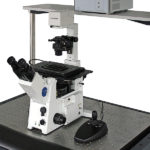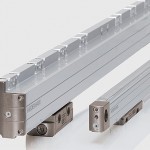Linear encoders are generally classified by their scanning technology — optical or magnetic. Magnetic encoders use a metal scale (often referred to as a “tape”), while optical encoders use a scale made of either metal or glass. Although magnetic encoders have seen great improvements in resolution and accuracy in recent years, for single-micron and sub-micron measuring resolution, optical encoders are still the better option. And of the two substrates available for optical encoders, glass substrates reign for applications that need resolutions down to the nanometer level.
A refresher on optical encoder technology

Optical encoders typically use some form of photoelectric scanning, based on either the reflection or diffraction of light, to determine position. The glass scale is marked with very fine lines, referred to as gratings or graduations, with a grating period (spacing) as small as just a few microns. The scanning reticle (part of the scanning head, or read head) has gratings that are the same as the scale.
In the imaging method of scanning, an LED source passes light through the scanning reticle. When the scanning reticle and scale move relative to each other, the light is modulated. If the gaps in the gratings align, light passes through, but if the lines of the reticle coincide with the gaps of the scale (or vice-versa), no light can pass through. Photovoltaic cells monitor these fluctuations of light and convert them into electrical signals to track movement.
Interferential scanning — typically used for grating periods in the range of 5 microns and smaller — uses 3-dimensional structures on the scale and relies on the diffraction and interference of light. As light passes through the reticle, it’s diffracted into three partial waves, and when these partial waves hit the scale, the 3-D gratings on the scale diffract the waves. The waves then meet again at the reticle, where they’re further diffracted and interfere with each other. As the reticle and scale move relative to each other, an alternating light intensity is produced. This change in light intensity is monitored by photovoltaic cells and converted into electrical signals.
When is sub-micron resolution really needed?

Image credit: Heidenhain
Arguably, the most common application for glass scale linear encoders is ultra-precision machining, especially grinding machines and lathes for optics and parts used in the aerospace industry. Parts that have been machined to single-digit or sub-micron accuracy must also be inspected, and glass scales enable measuring devices, such as coordinate measuring machines (CMMs), to carry out this task.
In addition to offering higher resolution than magnetic versions, glass scale linear encoders also have a much lower coefficient of thermal expansion, meaning the scale is virtually unaffected by changes in temperature, which can alter the pitch of the scale gratings and reduce measuring accuracy. Glass scale encoders can also be used in vacuum environments, including high and ultra-high vacuums.
But glass scales still remain somewhat of a niche product — in most cases, they’re only used where absolutely necessary. This is partly because of cost, but also because glass scale linear encoders pose different challenges to apply and integrate than magnetic versions. With a finer grating pitch than most magnetic encoders, any errors in mounting have a more pronounced effect on the accuracy of an optical scale.
Glass scales are much more rigid than magnetic tape scales, but the flatness of the mounting surface is more critical for glass substrates than for metal tapes. And mounting the read head requires alignment in five axes to achieve the correct air gap between the read head and the scale – a labor-intensive process.
Once an optical scale is mounted, protecting it from contamination is extremely important. Magnetic scales are, for the most part, sensitive only to magnetic contamination, whereas an optical encoder is sensitive to any debris that interferes with the transmission of light. This can be a difficult issue to overcome, since linear scales are mounted on the axis of travel, where the work is being performed, often putting the encoder directly at the source of chips, liquids, and other debris. The most common method for protecting optical encoders (especially glass scales) from contaminants is to enclose the scale in a housing, with the option of applying air purge to the housing for even greater protection against dirt and liquids. But enclosures add cost, wear points, and hysteresis, which itself can interfere with measurement accuracy.

Image credit: Heidenhain







Thanks for sharing such an insightful article on the encoders. Keep posting.